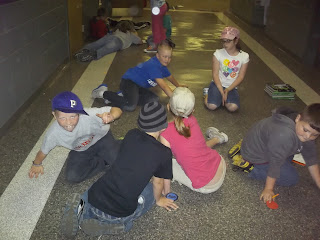Marbelous Rolls
There's nothing better than a science activity that involves marbles and ramps. To my students that is equal to Christmas morning! Okay, maybe Santa is more exciting but they do love it when science involves fun learning tools. For this activity the students are investigating how friction can change an object's motion. Within this same lesson other force concepts like kinetic/potential energy, force, motion, and Sir Issac Newton's Laws of Motion are also supported. I was even able to incorporate several math concepts with measurement, mean, median, mode and range. Talk about JACKPOT! This lesson was filled to the brim with learning and the students just loved it.
Cast and Crew: 5 textbooks, Marbelous Job Tokens, mini post-its, measuring tape, marble, ruler ramp.
Students are grouped into sets of 5 (if possible). There are 5 trials and 5 job tokens. The jobs are rotated with each trial providing each student the opportunity to participate in each job.
The Ruler Ramp is made by placing to rulers side by side. On the front use clear tape to tape them together. Then flip the rulers over and fold to form a right angle. Then use masking tape to hold in place.
Ta da---Ruler Ramps!
The students begin Trial 1 on a non-carpeted area. They set up a ramp using 1 textbook and the ruler ramp. The Marble Roller then rolls the marble down the ramp.
The Marble Marker places the post-it note where the marble lands. The Marble Catcher catches the marble and holds it tight until the next trial.
The Marble Measurer uses the measuring tape to measure from the end of the ruler ramp to the post-it note. The Record Keeper records this data on their record sheet. This process continues for 5 trials. With each trial one more textbook is added to the ramp and the jobs rotate.
After the first non-friction trials the students work together to find the mean, median, mode, and range of the data collected. (Have I mentioned that I LOVE, LOVE when I can "double dip"!!)
Round 2: The Friction Trials can be done on the same day or on a follow up day.
We are lucky to have a library with carpet so our investigations took place in there.
The process is exactly the same with the exception that, of course, the results are quite different.
I liked how they investigated with the non-friction surface first as they instantly noticed the drastic difference in the speed and distance of the rolls.
This is one "Marbleous" force and motion activity I will certainly be using again.




































